Weekly Notes from the Yohkoh Soft X-Ray Telescope
(Week 37, 2002)
Science Nugget: Sep 13, 2002
A Little Bit of (Naked Eye) Sun Spot History
Introduction
The
week 23 Nugget described The Yohkoh Galileo Project; a project
to archive all the data collected by the Yohkoh mission in an easy to
access, easy to use format. The project name was inspired by the solar
observations of Galileo
Galilei, whose meticulous drawings are still of scientific use today.
Galileo however was not the first to document sun spots. This nugget
delves a little into some historical sun spot observations of interest and
some of the early thoughts as to what they were.
It is only in the last 200 years that astronomers came to the conclusion
that sun spots are concentrations of strong magnetic fields piercing the
solar photosphere. Visually, they look like dark blemishes on the solar
disk. Most sun spots are too small to be readily visible by naked eye
observations, but some reach a size sufficient to be visible without a
telescope, under suitable viewing conditions (for example, when the sun is
partially obscured by fog or thick mist, or clouds). However, because of
their possible astrological significances, reports of naked-eye sun spot
observations are indeed to be found in many ancient chronicles and court
chronologies.
Chinese Records
The Chinese have among the earliest records of astronomical
observations, with systematic and detailed histories since the 3rd century
B.C. and less well documented observations going back several thousand years.
The two oldest records of a sun spot observation are found in the Book of
Changes, probably the oldest extant Chinese book, compiled in China around
or before 800 B.C. The text reads "A dou is seen in the Sun", and "A
mei is seen in the Sun". From the context, the words (i.e., Chinese characters)
"dou" and "mei" are taken to mean darkening or obscuration.
Some sun spots records describe these darkenings as like a star, bird,
melon, egg, fruit and even a man. In the legend times, the god of the sun
was a black bird with tree legs on the splendid disc. The old Chinese
character for "sun" is also a black point in a circle.
Astronomers at the court of the Chinese emperors made regular notes of
sun spots. It seems however, that observations were not carried out
systematically for their own sake, but instead took place whenever
astrological prognostication was demanded by the emperor.
From the year 28 B.C., comes the report "Heping reign period, 1st year, 3rd
month, day Guiwei, the rising sun was yellow; a black gas was at the
center of the sun, like a coin".
During the period from 28 B.C. to 1638 A.D. there are 112 descriptions
of outstanding sun spots in the official Chinese histories.
Where were the Greeks?
The Greeks were renowned for their astronomical observations,
but there are few recorded observations of sun spots in the west until the
1600's;
although one of the earliest of all recorded observations was by Theophrastus
(374-287 B.C.) in the fourth century B.C. Part of the reason for this was
because of the dominating views of
Aristotle (384-322 BC) concerning the incorruptibility of the heavens.
Aristotelian philosophy maintained the Sun was a
perfect sphere (philosophically speaking) and without blemish. This meant
that sun spots were "physically impossible", so that sightings were ignored
or ascribed to transit of Mercury or Venus across the solar disk. Indeed, Johannes
Kepler (1571-1630) misinterpreted a spot seen on May 18, 1607 as being exactly this.
Later, "the perfection of the heavens" became part of orthodox Christian
theology, similar to
the belief that the earth was the
center of universe and all the planetary bodies revolved around it.
The Europeans Are Coming
The 12th century drawing below, from the Chronicles of John of Worcester (one of the many
monks who contributed to the Worcester Chronicles), represents what may be
the first surviving sun spot drawing, from a sighting on Saturday, 8 December
1128.
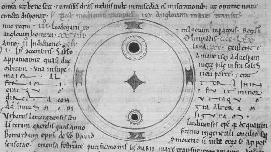
The accompanying text translates: "...from morning to
evening, appeared something like two black circles within the disk of the
Sun, the one in the upper part being bigger, the other in the lower part
smaller. As shown on the drawing." The fact that the Worcester monks
could apparently distinguish the umbrae and penumbrae of the sun spots they
observed suggests that the spots must have been exceptionally large.
It wasn't until the early 1600's that sun spot observations began in
earnest, coinciding with the invention of the telescope. The first
telescopic observation of the sun probably belongs to Thomas Harriot
(1560-1621) on Dec 8th, 1610. He was one of four
prominent observers at this time using telescopes to look at the sun.
They were Johann Goldsmid (1587-1616,
known as Fabricius) in Holland, Thomas Harriot in
England, Galileo Galilei (1564-1642) in Italy, and the Jesuit Christoph
Scheiner (1575-1650) in Germany. Fabricius is credited with associating
sun spots with the axial rotation of the sun, a view which Galileo made the
convincing case for. Galileo's views on sun spots
contributed significantly the sequence of events that landed him in front
of the Roman Inquisition in 1633, but growing animosity on the part
of the Jesuits who, in particular through their chief astronomer
Christopher Clavius (1538-1612), also contributed to Galileo's downfall.
[Academic jealousy is nothing new!]
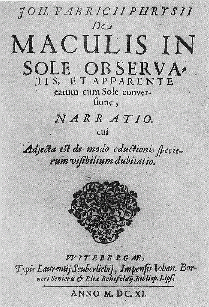 |
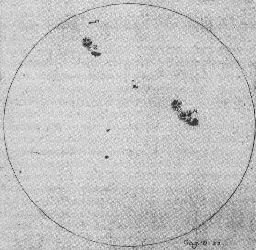 |
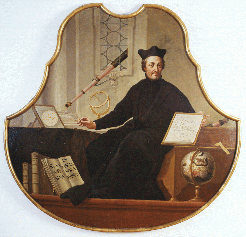 |
| Fabricius' de Maculis in Sole observatis et apparente earum cum Sole
conversione, Narratio - Account of Spots observed on the Sun and of
their apparent rotation with the Sun. |
Reproduction of one of Galileo's sun spot drawings. The
umbrae/penumbrae structure is clearly depicted on this June 23 1612
drawing. |
A picture of Christoph Scheiner. Scheiner's original opinion was that sun spots were small planets
closely orbiting the Sun. |
After this burst of discovery and observation, sun spot observation went
dormant for many years. In a letter to Humphrey Marshall dated, London, February
14, 1773, a Mr B. Franklin comments about the sun spot observations
Marshall had sent him
...The observations I communicated to our
astronomers of the Royal Society, who are much pleased with them, and hand
them from one to another; so that I have had little opportunity of
examining them myself, they not yet being returned to me.
Here are various opinions about the solar spots. Some
think them vast clouds of smoke and soot arising from the consuming fuel
on the surface, which at length take fire again on their edges, consuming
and daily diminishing until they totally disappear. Others think them spots
of the surface, in which the fire has been extinguished, and which by
degrees is rekindled. It is remarkable, that, though large spots are seen
gradually to become small ones, no one has observed a small spot gradually
become a large one; at least I do not remember to have met with such an
observation. If this be so, it should seem that they are suddenly formed
of their full size; and perhaps, if there were more such constant and
diligent observers as you, some might happen to be observing at the
instant such a spot was formed, when the appearances might give some ground
of conjecture by what means they are formed.
The professor
of astronomy at Glasgow, Dr. Wilson, has a new hypothesis. It is this;
that the sun is a globe of solid matter, all combustible perhaps but whose
surface only is actually on fire to a certain depth, and all below that
depth unkindled, like a log of wood, whose surface to half an inch deep
may be burning coal, while all within remains wood. Then he supposes, by
some explosion similar to our earthquakes, the burning part may be blown
away, leaving bare the unkindled part below, which then appears as a spot,
and only lessened as the fluid burning matter by degrees flows in upon it
on all sides, and at last covers or rekindles it. |
The Wilson referred to in this letter was the Astronomer Royal, Alexander
Wilson. In 1769 he discovered the "Wilson effect". Wilson had been
observing a large sun spot as it approached the edge of the Sun and noticed
that its appearance changed. The penumbra on the side remote from the
limb appeared to contract and then disappear. When the same spot
re-appeared on the other side of the Sun two weeks later the same
behavior was shown on the penumbra on the opposite side of the spot.
Wilson explained his observation with the hypothesis that the spots were
saucer shaped depressions on the Sun's surface formed by the partial
removal of luminous matter which he believed to cover the supposedly dark
solid interior of the Sun.
A few years later, William Herschel
(1738-1822; discoverer of the planet Uranus),
following on from Wilson's hypothesis, suggested
that sun spots were opening in the Sun's luminous atmosphere, allowing
a view of the underlying, cooler surface of the Sun (likely inhabited, in
Herschel's then influential opinion). A drawing of Herschel's is shown
below.
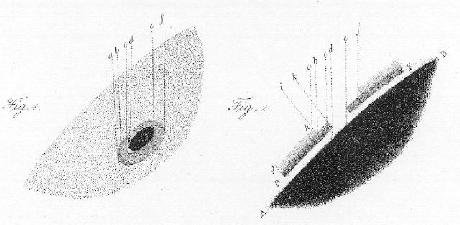
It would be at the beginning of the 19th century that the true nature of the sun
and sun spots would start to be understood, through the field of spectroscopy
and the work of Fraunhofer (1787-1826),
Gustav Kirchhoff (1824-1887), Robert Wilhelm Bunsen (1811-1899), and
Anders Jonas Ångström (1814-1874), to name but a few.
In 1857 Heinrich Schwabe was presented with the Gold Medal of the Royal
Astronomical Society for his discovery of the sun spot cycle. He observed
and recorded sun spots for 43 years and he found about a 10 year period in
the appearance of the spots. This had not been noticed in 200 years of
observing sun spots.
This work interested another man, Richard Carrington, so much that he also
began to systematically observe sun spots between 1853 and 1861. He
discovered that sun spots undergo a latitude drift. That is, that the
average latitude of the spots decreases steadily from the beginning to the
end of the solar cycle and get closer to the solar equator.
With the introduction of photographic studies of sun spots in the latter
half of the 1800's, the old era of naked eye discovery on the Sun came to an
end.
References:
Traditional Chinese Astronomical Records, Li CiYuan -
IAU Commission 41 : Meetings : Astronomical Archives Session
Historical Sun Spot
Drawing Resource Page: The Early Observers, 1128 to 1800 AD.
Great Moments of Solar Physics (1):
Sunspots
[Topical
index] -o- [Chronological
index]
September 13, 2002
Alisdair Davey ard@solar.physics.montana.edu


